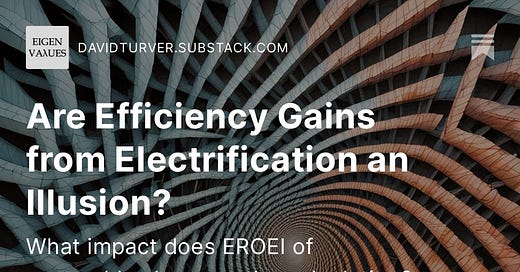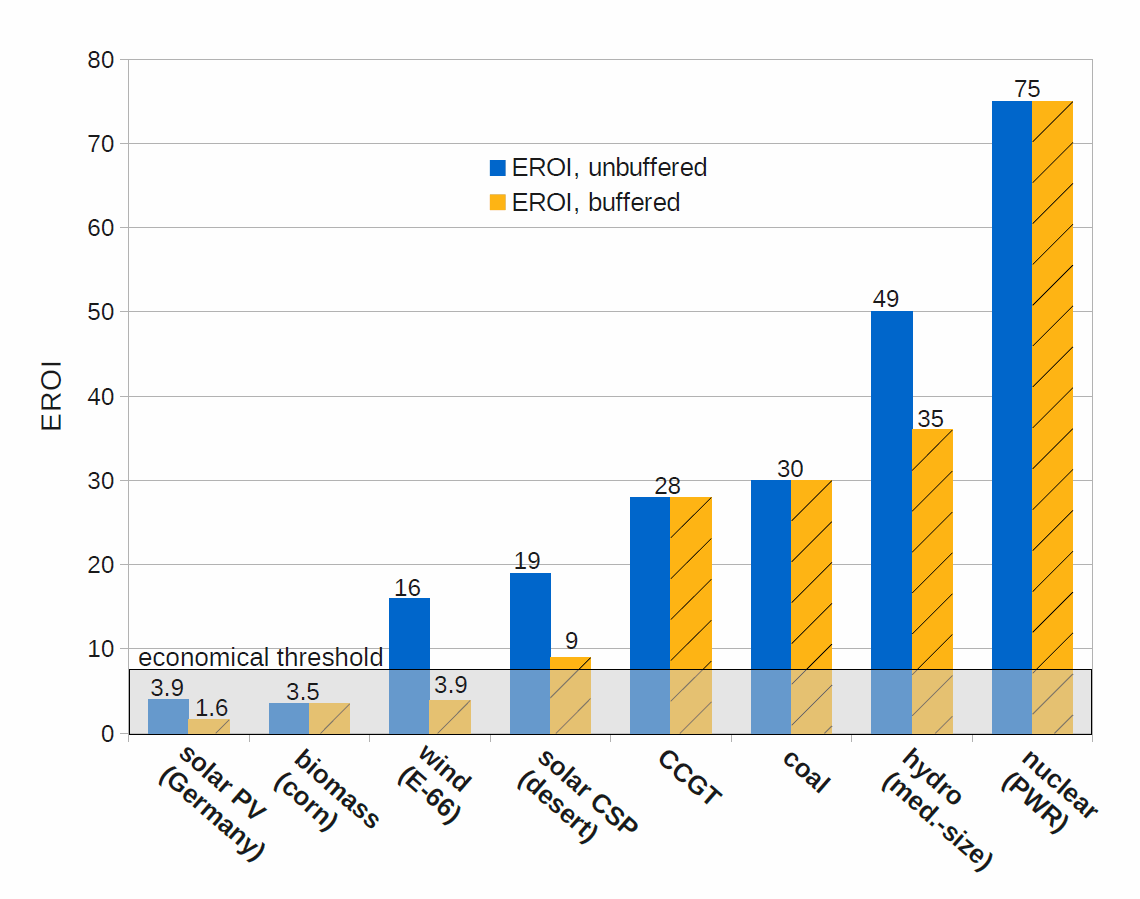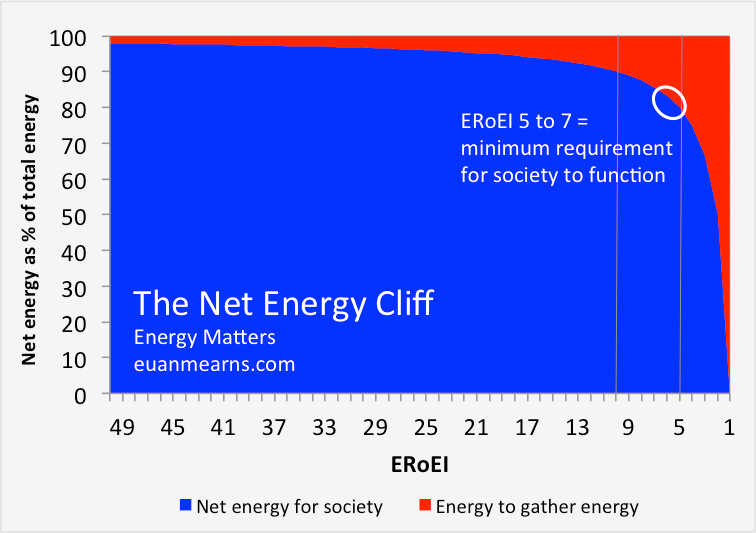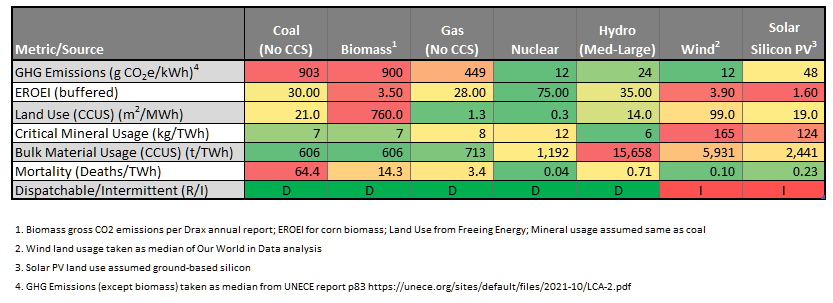Are Efficiency Gains from Electrification an Illusion?
What impact does EROEI of renewables have on the calculation?
Introduction
The inspiration for this week’s article comes from Hannah Ritchie again and her recent article analysing a study by Oxford professor Nick Eyre. The study estimates that a move from a largely hydrocarbon-fuelled world to an electrified world powered by renewables and hydrogen will result in a substantial reduction in overall energy use as seen in Figure 1 (credit: Hannah Ritchie, using Nick Eyre’s data).
I have some doubts about this analysis as will be shown below. However, I have posed this article as a question and not a statement in the hope that some of the learned people who frequently comment on my articles will be able to add something to this analysis.
Adjusting Nick Eyre’s Analysis
The first point to note is that in Nick Eyre’s analysis the red “fuels” component changes from fossil fuels in the current energy system to hydrogen in the post-transition system. This hydrogen must be made by electrolysis. The efficiency in making hydrogen by electrolysis might be around 60% today, so we would need 57/0.6=95EJ of electricity from renewables to make the hydrogen. His analysis has been adjusted to include total electricity requirements as shown in Figure 2.
This results in 284EJ of electricity being required to operate the post-transition system. For the purposes of this analysis, the optimistic assumptions about the efficiency gains in road transport and space heating embedded in the report have been ignored. The 60% efficiency of electrolysers is at the top end of what can be achieved today according to the IEA, but the IEA do anticipate an improvement to 67-74% by 2050.
Energy Transition in EROEI Terms
The root of my concern about Hannah’s article and Nick Eyre’s analysis is what happens if you consider the current and post-transition energy system in terms of Energy Return on Energy Invested (EROEI). I covered the detail of why EROEI matters here.
The EROEI (aka EROI) of using various fuels to produce electricity was covered in a seminal paper by Weissbach in 2013 and his main result is shown in Figure 3 below.
As can be seen above, in round numbers, the EROEI of a largely coal and gas-fired electricity system is around 30. Whereas the EROEI of a wind and solar powered system, including buffering to account for intermittency will be about 3, depending upon the mix of solar and wind. Note that this is below the economic threshold of about 7 estimated by Weissbach. Note also that the entire energy system might have a different EROEI. Space heating using gas might have an EROEI of ~60 using modern gas boilers. Whereas the EROEI of using petrol-fuelled cars might have an EROEI of say 15. Essentially, I have assumed these two effects cancel each other out to give an overall energy system EROEI of ~30.
Now consider what this means in terms of the net energy cliff as described by Euan Mearns as seen in Figure 4.
With an EROEI of 30, about 96.7% of gross energy is available as net energy for society. Or, looking at it the other way round, to produce 100 units of net energy for society, we need 103.4 units gross energy.
With an EROEI of 3, only two thirds of the gross energy is available as net energy for society. We “spend” one third of gross energy gathering and generating the energy we need to live. Or looking at it the other way round again, we need 50 extra units to give a total of 150 units of gross energy to produce the same 100 units of net energy for society.
Applying this to the current and post-transition energy systems above we get the following result shown in Figure 5.
To produce that 284EJ of electricity using wind and solar renewables in the post-transition world, we would need 284 * 1.5 = 426EJ of gross energy or an extra 142EJ. The current world, running on an EROEI of 30 needs 430EJ of energy. Or about the same as the post-transition world.
I accept that I have used a few shortcuts in this analysis and each of the assumptions I have used could be open to challenge. However, the concept outlined has merit and illustrates that the alleged efficiency gains from electrification using renewables is largely an illusion. Dumas et al came to similar, albeit less extreme, conclusions than above when looking at the Belgian energy system.
Economic and Social Impact
In the example above we have to ask where the extra 50 units of gross energy come from? Or in the Eyre model where the extra 142EJ of energy comes from? In the global context, there needs to be another high-EROEI source of primary energy, or even more renewables to generate the energy required to make the turbines and PV panels for the renewables system.
If we restrict ourselves to the UK, the extra gross energy required to make the energy collecting devices needs to come from somewhere. It either comes from the dwindling pool of net energy or more likely, it comes in the form of the embedded energy in the turbines or solar panels imported from countries with surplus primary energy. This primary surplus is likely to arise in high-EROEI countries using coal, gas, oil or nuclear. If we are spending so much on (embedded) energy imports, what goods and services are we going to export to balance the books and generate hard currency to pay for the imports?
An example of where we might be heading comes from a recent post (tweet) on X (Twitter) by the Shadow Chancellor, Rachel Reeves (see Figure 6).
The article makes clear that what Reeves means by “invest” is to spend £3bn over a decade to “green” UK steelmaking. This involves using hydrogen to make steel rather than coal. However, hydrogen is more expensive than coal, so it will require a subsidy. Labour, remember have an insane plan to decarbonise the electricity grid by 2030. It seems they expect our electricity and new hydrogen process to be so expensive that both will require extensive subsidy to be economic. This is what the slow, creeping death of industry looks like as we slip down the net energy cliff.
I am certainly not alone in fearing the economic and social consequences as this paper by Jessica Lambert et al from 2013 illustrates. The authors found that a societal wellbeing peaks with an EROISOC of 30 or above. Probably because with EROEI>30, the gross energy used by society is not that much more than net energy consumed. However, they also found that an EROISOC of <25 indicates poor or moderate quality of life that declines as EROISOC falls.
Transition Impacts
In addition, during the transition, the effect may be worse than indicated above. During the shift to renewables, the wind turbines and solar panels will consume lots of energy as they are manufactured, and this will only be “paid back” during their operating life.
Moreover, this analysis has not taken into account the much higher mineral content in electric vehicles (EVs) compared to internal combustion-engined (ICE) vehicles. Mineral content is a proxy for embedded energy content, so the manufacture of EVs will consume more energy than ICE cars even if there are some gains during their useful life.
The combined effect of renewable energy plus EVs will effectively bring forward energy demand, meaning we need to consume more energy during the transition than otherwise would be the case. If we do not build extra energy capacity during the transition, then either there will be less energy available for normal day to day activities, or we import more embedded energy.
What about Nuclear instead of Renewables?
However, if we electrify using nuclear, it would be a different story. As seen in Figure 3, the EROEI of a largely nuclear electricity system will be >70, accounting for some flexible capacity to manage peaks and troughs in demand.
Nuclear power is also much less mineral intensive than renewables, as discussed here and shown in Figure 7.
Therefore, moving to nuclear instead of renewables will avoid some of the extra energy required to mine and refine all the minerals required for a new renewables energy system. With such a high EROEI from nuclear, it should allow the extra energy required for EVs to be absorbed and possibly generate enough surplus energy for our own domestic energy-intensive industries. We would have an energy abundant environment.
Conclusions
As stated earlier, some may quibble at the details of this analysis. However, applying the concept of EROEI to Eyre’s analysis is valid, and even with different parameters, the alleged efficiency gains from electrification using renewables would reduce significantly, if not completely evaporate. The supposed efficiency gains from electrification of the whole economy using renewables as the primary energy source are largely an illusion. The underlying paper from Nick Eyre does not even mention the concept of system wide EROEI, let alone address the issues raised by slipping down the net energy cliff.
Personally, I think before we go any further down the path of wind and solar renewables, with or without hydrogen, the Government should commission some rigorous academic research into the economic and social impacts of low EROEI energy systems to build on the work of Lambert et al referenced above. Any additional insight from expert commenters is welcome below.
My own view, as expressed before, is that the only scalable, sustainable solution that will deliver abundant energy is nuclear. And we need to learn the lessons of how to make it cheaper. The sooner we start, the better.
If you have enjoyed this article, please share it with your family, friends and colleagues and sign up to receive more content.











Electric resistance heating is as Inefficient as one can get . Criminally absurd to try to ban gas in climates that commonly reach -10c for months .
Hydrogen is not happening. It's virtually impossible to transport, to contain, with continuous losses. Only rapid use at the source is worthwhile. Over and over someone proposes liquid hydrogen pipelines and "free superconducting in the pipeline". It's ridiculous nonsense. A synthetic hydrocarbon fuel economy could work, but never with renewables.